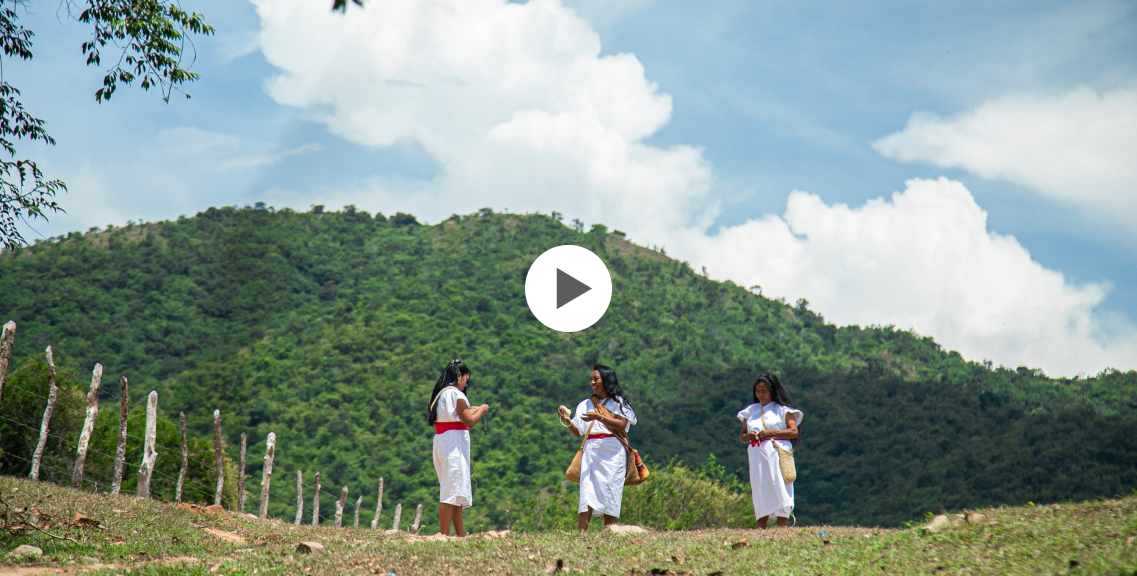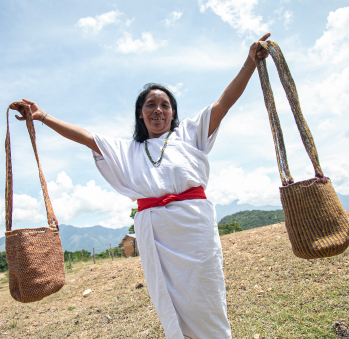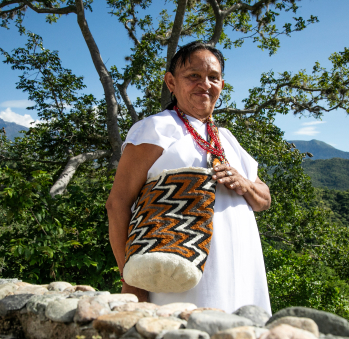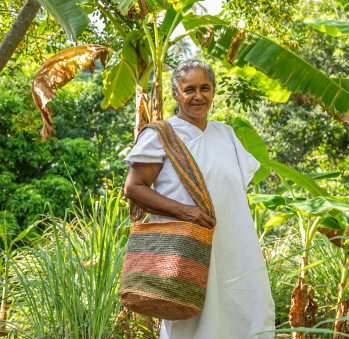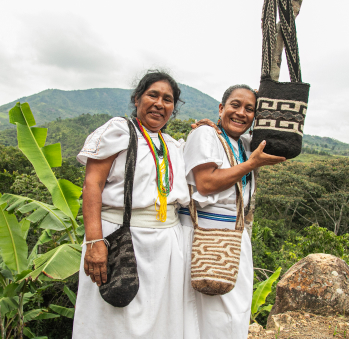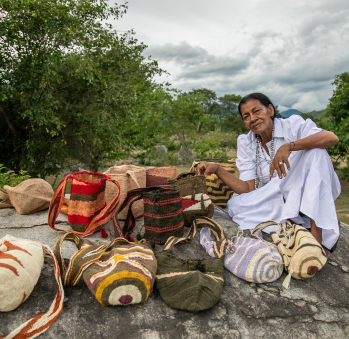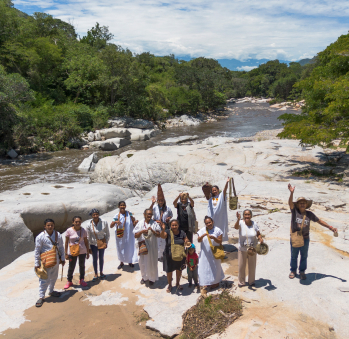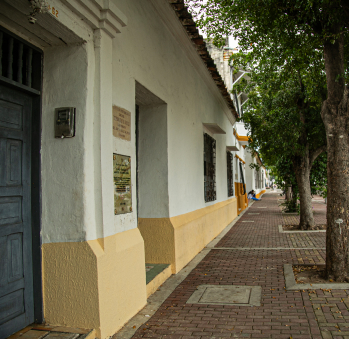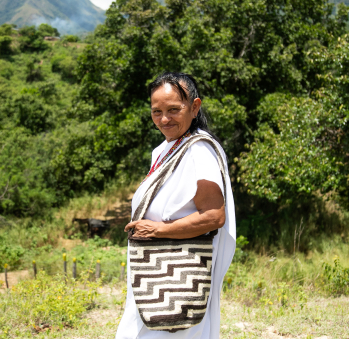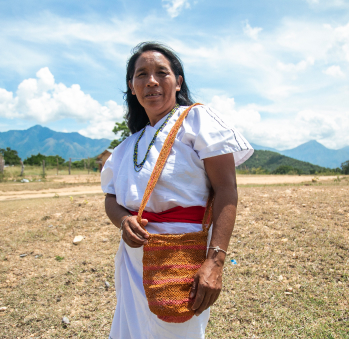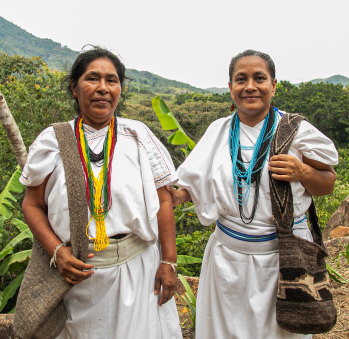Cesar Route
In Cesar, two cultural traditions coexist, each possessing a profound beauty: one characterized by intricate stitches and the other by enchanting sounds and lyrics—the art of weaving bags and Vallenato music. In the warmth of this land, cradled by the Sierra Nevada de Santa Marta and the Serranía del Perijá, sounds, stitches, and flavors have interwoven beneath the shade of mango and mamoncillo trees. We hope you thoroughly experience and savor this journey, leaving you captivated and serene.
The Sierra Nevada de Santa Marta, inhabited and protected by the indigenous people Arhuaco, Wiwa, Kankuamo, and Kogui, is the fertile terrain that has nurtured the tradition of bag’s weaving. From this land spring magueyes, which fibers are transformed into fique, and sheep are raised to provide the wool for the weaving artisans. Fique and wool are the fibers used for weaving each stitch, spiraling upwards to form each bag, much like the inhabitants’ feet have traversed the Sierra’s mountains.
Nestled at the slope of the imposing, mystical, and festive Sierra is Valledupar, the epicenter of this artisanal route. In the northern outskirts of this enchanting city, you will meet the Wiwa and Kankuamo artisans and their fique bags. To the south, in Pueblo Bello, you’ll encounter Arhuaco weavers crafting woolen bags. Guided by these women, who safeguard and pass down ancestral wisdom, you’ll uncover a tradition deeply influenced by the landscape. The silent work of the weavers, intertwined with contemplation, contrasts with the Vallenato songs dedicated to the land and love. As you explore the streets of Valledupar, indulge in rosquete pastries or an arepa de queso, accompanied with corn water. Plan a visit to this department at the end of April to enjoy the legendary Valledupar Vallenato Festival. Bear in mind that the rainy season spans from September to November, and the month of May, meaning that the entry to some jurisdictions may be flooded.
Embark on a journey full of history
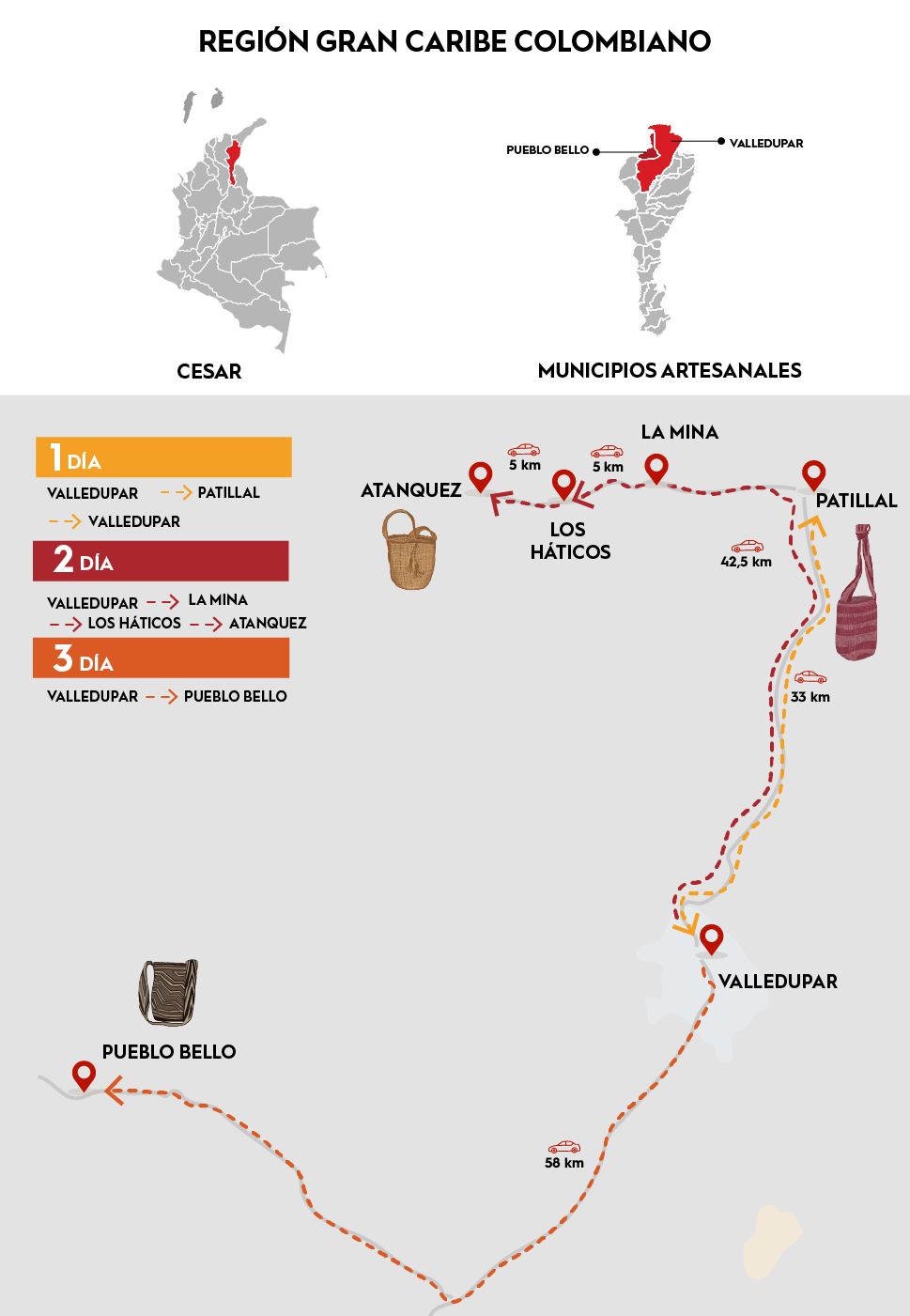
Artisans along the way
Artisans along the way
We recommended this tour
Schedule the visit in advance with the artisans.
Carry cash.
3 days
Car or Bus
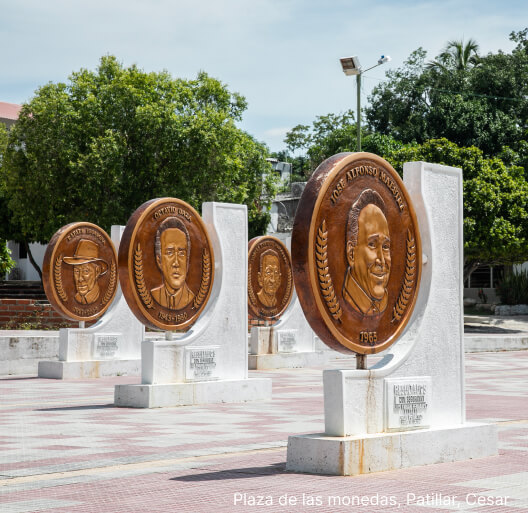
Valledupar — Patillal — Valledupar
Arrive at Alfonso López Pumarejo Airport or Valledupar Bus Terminal and head to Patillal, 32 kilometers away. Along the way, you can enjoy a cocotazo, a buñuelo made with corn dough, and upon reaching the renowned town immortalized in Vallenato songs, explore Las Monedas Square, which narrates the history of vallenato’s juglares.
Next, visit Gloria Malo and her community of weavers in the Wiwa reservation of Tejunke, twenty minutes from Patillal, and delve into the significance of Wiwa stitches and magueyes.
Upon returning to Valledupar, the city’s streets and roundabouts, known as rompois, recount the history of Vallenato music and its people. Don’t miss the María Concepción Loperena Square, leading to Alfonso López Square, where the kings of Vallenato are commemorated on its floor tiles. The route takes you past Nuestra Señora del Rosario Parish, patroness of the city with a 450-year history. Nearby stands Loperena National School, attended by prominent Vallenato musicians sucha as Escalona, Rafael Orozco and Diomedes Díaz. Once you reach Alfonso López Square, you’ll be close to the historic center and El Cañahuate, the city’s first neighborhood. If time allows it, visit the Accordion Museum or El Cuartico Memory Center. For a hearty lunch of sancocho soup, we recommend El Totumazo restaurant. Further recommendations include Típicos Eloy for breakfast, Compae Chipuco for savoring traditional dishes, and La Razón for trying countryside food. Each restaurant offers a comistrajal, the term used at Valledupar for their generously portioned and delightful dishes.
Valledupar — La Mina — Los Haticos — Atanquez — Valledupar
Heading north from Valledupar, you’ll enter the indigenous Kankuamo reservations to meet four wise weavers. Onilda Rodríguez and La Maye are located in La Mina, 42 kilometers from Valledupar, close to La Mina’s river bathing area, where you can relax and swim among giant white stones resembling prehistoric eggs. A ten-minute drive from La Mina brings you to Élsida Arias in Los Haticos, followed by Aura Montero in Atanquez, the Kankuamo indigenous capital, a ten-minute drive from Los Haticos. Should you visit in mid-June, you can partake in Atanquez’s popular Corpus Christi celebrations. Plan to return to Valledupar before dusk.

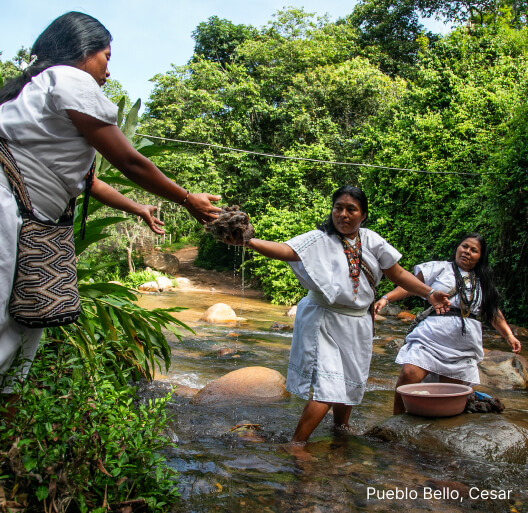
Valledupar — Pueblo Bello
Our journey concludes in Pueblo Bello, with a chillier climate and the Sierra’s purifying air. Anariakna Mestre, Yamile Conrado, and Kevia Chaparro will welcome you and show you, among many things, what the symbolism of bags with feminine or masculine thoughts mean. Don’t miss the opportunity to spend the night in Pueblo Bello, exploring its white streets in the afternoon and visiting the Arhuaco Center of Historical Memory, all while relishing its marvelous natural surroundings.
¡Until we meet again!
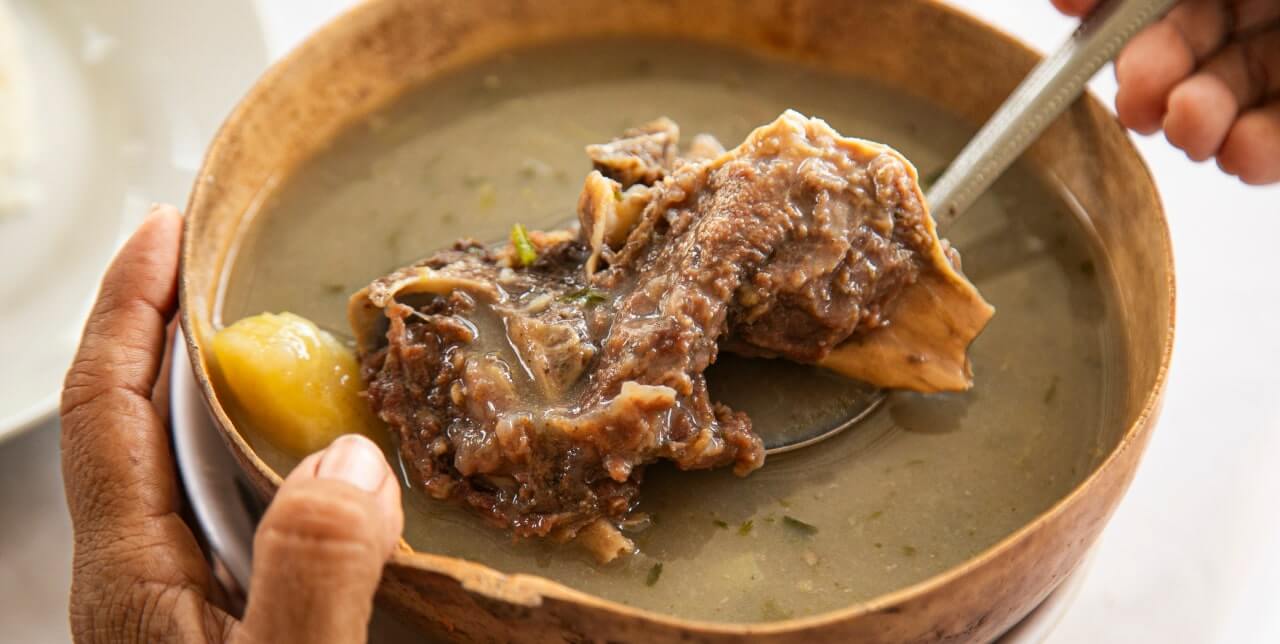
Traditional cuisine
and typical bites
Don't leave without eating this 
El chivo guisado o en sopa es uno de los platos de tradición culinaria presentes en los hogares cesarenses. El chivo se cocina con especias, verduras y leche de coco, y se sirve con arroz, yuca y plátano. Es una carne muy sabrosa y nutritiva que se disfruta en cualquier ocasión. Pruébalo en El Hotel Mama o en Wayuunaiki.
To lunch we go 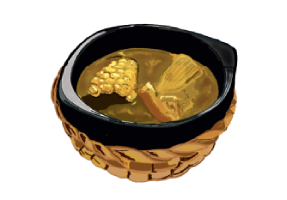
- La gallina guisada es otro plato tradicional que se elabora con gallina criolla, cebolla, tomate, ajo, comino y otros condimentos. Se guisa lentamente hasta que la carne esté tierna y jugosa, y se sirve con arroz blanco y yuca cocida. Es un plato muy aromático y reconfortante que se suele comer en familia o en fiestas. Hay que probarlo en Montacargas de la 12.
- El hígado en bistec es una receta muy fácil de realizar, práctica y económica. El hígado se lava con limón, se macera con vinagre, sal y aceite, y se fríe con cebolla roja y tomate. Se acompaña con arepa o pan. Es un plato rico en hierro y proteínas que se consume frecuentemente en el desayuno o el almuerzo. El mejor, en María Namén o en Montacarga del Norte.
- El sancocho vallenato es el plato por excelencia de la parranda vallenata, ya que se dice que vallenato con hambre no canta. Es una sopa espesa que lleva costillas de res, yuca, plátano verde, ñame, malanga, arracacha, ahuyama, mazorca, cilantro y cebollín. Se cocina a fuego lento hasta que todos los ingredientes estén suaves y sabrosos, y se sirve en totumas con cuchara de totumo. Es un plato muy sustancioso y energético que se disfruta en compañía de amigos y música. Hay que disfrutarlo en el Totumazo de la Ceiba en la 12.
Flavors to discover and snack on 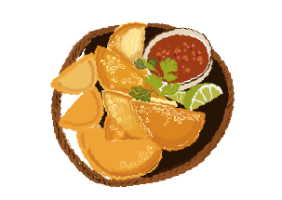
La arepa de queso es una comida típica vallenata que se prepara con harina de maíz o maíz molido, mucho queso costeño rallado y mantequilla. Se asa a las brasas sobre una hoja de plátano, y se puede acompañar con carne, chicharrón, huevo o mantequilla. Es una arepa suave, esponjosa y deliciosa que se come a cualquier hora del día. Disfrútala en los restaurantes Estrato 6 o en Las Majomas.
To sweeten the palate and unmissable drinks 
Valledupar y la zona norte del departamento tienen sus dulces caseros típicos que siempre se quieren comer, inclusive en momentos especiales. En donde Cecy Dangond se destacan los más importantes: el dulce de leche, dulce de plátano maduro, dulce de papayita, dulce de toronja, panochas, queques y cuques. Estos dulces son de consumo diario.
- El dulce de leche se prepara con leche, azúcar y bicarbonato de sodio. Se cocina a fuego lento hasta que se espese y tome un color caramelo. Se puede comer solo o acompañado de queso o pan.
- El dulce de plátano maduro se hace con plátanos maduros pelados y cortados en trozos, que se cocinan en agua con azúcar, canela y clavos de olor. Se sirve frío o caliente, según el gusto.
- El dulce de papayita se elabora con papayitas verdes ralladas, que se mezclan con azúcar y jugo de limón. Se deja reposar por unas horas y luego se cocina hasta que se forme un almíbar espeso. Se puede decorar con coco rallado o queso.
- El dulce de toronja se hace con cáscaras de toronja cortadas en tiras finas, que se remojan en agua con sal por un día. Luego se escurren y se cocinan en agua con azúcar, canela y clavos de olor hasta que estén tiernas y brillantes. Se conservan en frascos con su almíbar.
- Las panochas son unas tortas de queso con anís en grano, que se hacen con harina de maíz, queso rallado, azúcar, huevos, mantequilla y anís. Se amasan bien y se forman unas bolitas que se aplastan y se fríen en aceite caliente. Se pueden comer solas o con miel.
- Los queques son unos bizcochos esponjosos y dulces, que se hacen con harina de trigo, azúcar, huevos, mantequilla, leche, polvo de hornear y vainilla. Se baten bien los ingredientes y se vierten en moldes engrasados. Se hornean hasta que estén dorados y se desmoldan. Se pueden rellenar o cubrir con crema, chocolate o frutas.
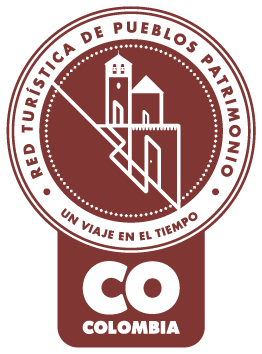
Pueblo Patrimonio
La Red Turística de Pueblos Patrimonio de Colombia es un programa especial del Ministerio de Comercio, Industria y Turismo, ejecutado por FONTUR, que trabaja con 17 municipios de Colombia que poseen declaratoria de Bien de Interés Cultural (BIC) a nivel nacional para su valoración y proyección mediante el turismo, generando así más oportunidades de desarrollo y sostenibilidad en las comunidades.

La Medalla a la Maestría Artesanal es un galardón que Artesanías de Colombia entrega anualmente, con el cual se hace un reconocimiento a aquellos artesanos, empresas y comunidades artesanales que, contando con una trayectoria destacada, sobresalen a nivel nacional por su excelencia en el oficio así como por preservar el quehacer artesanal.

Denominación de Origen
Es un signo distintivo que identifica productos reconocidos o famosos por tener una calidad o características específicas derivadas esencialmente del lugar de origen y la forma tradicional de extracción, elaboración y producción por parte de sus habitantes. La protección conferida sobre una Denominación de Origen implica que ninguna persona puede identificar con la denominación protegida productos iguales o similares a los amparados, cuando no provengan del verdadero lugar y no cumplan con las características o calidades que le han dado la reputación al producto reconocido. Las Denominaciones de Origen para productos artesanales colombianos que han sido protegidas por la Superintendencia de Industria y Comercio en nuestro país son actualmente 12.
No puede copiar contenido de esta página








































